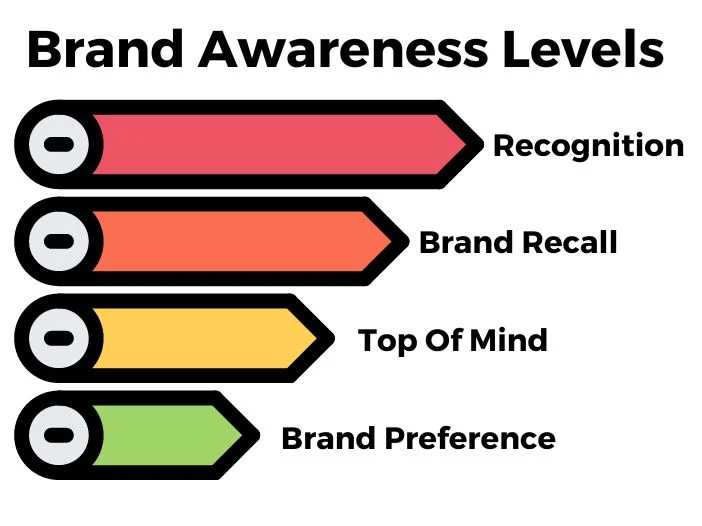Brand Awareness; What is it and How it works.

Introduction Brand awareness is the foundation of a successful business. It determines how well customers recognize and remember your brand. In a crowded marketplace, having a great product or service is not enough—you need a strong brand presence to stand out. This guide will explain what brand awareness is, why it’s important, and the best strategies to improve it. What Is Brand Awareness? Brand awareness refers to how familiar consumers are with your brand and how easily they recognize it. It includes everything from your logo, slogan, and colors to how people feel and think about your business. There are two key types of brand awareness: Brand Recognition – When people can identify your brand by its visuals, such as your logo or packaging. Brand Recall – When customers remember your brand without any visual cues, based on experience or word of mouth. A strong brand awareness means that when people need a product or service you offer, they think of your brand first. Why Is Brand Awareness Important? 1. Builds Trust and Credibility People prefer brands they recognize and trust. A strong brand presence helps establish credibility, making customers feel more confident in choosing your business. 2. Increases Customer Loyalty When people are familiar with your brand, they are more likely to return and repurchase. Loyal customers not only buy more but also recommend your brand to others. 3. Drives More Sales Consumers often choose brands they recognize over unfamiliar ones. The more people are aware of your brand, the higher your chances of converting them into customers. 4. Helps Differentiate from Competitors Brand awareness sets you apart from competitors. If customers associate your brand with quality, reliability, or innovation, they will choose you over others. 5. Supports Marketing and Advertising Efforts The more people know your brand, the more effective your marketing campaigns will be. Recognizable brands get higher engagement and better ROI on ads. How to Build Brand Awareness 1. Create a Strong Brand Identity Your brand identity is how people recognize your business. It includes: Logo – A unique and memorable design. Color Scheme – Consistent brand colors. Typography – Fonts that match your brand personality. Brand Voice – A distinct way of communicating with customers. A consistent brand identity helps customers recognize your business across all platforms. 2. Leverage Content Marketing Content marketing is one of the best ways to increase brand awareness. Providing valuable, engaging content helps you attract and retain customers. Effective content marketing strategies include: Blogging – Write articles that answer customer questions. Videos – Create engaging content on platforms like YouTube and TikTok. Infographics – Share visual content that simplifies complex information. Podcasts – Start a podcast to discuss industry topics and connect with your audience. Pro Tip: Optimize your content for SEO so that your brand appears in search engine results. 3. Use Social Media Marketing Social media is a powerful tool for building brand awareness. It allows businesses to reach a larger audience and engage directly with customers. How to grow brand awareness on social media: Post consistently and maintain a unique brand voice. Interact with followers through comments, shares, and direct messages. Run social media contests and giveaways to encourage engagement. Collaborate with influencers to expand your reach. Use hashtags to increase discoverability. 4. Invest in Paid Advertising Paid ads can quickly increase your brand’s visibility. Platforms like Google Ads, Facebook Ads, and Instagram Ads help businesses reach their target audience effectively. Best advertising strategies for brand awareness: Use display ads to showcase your brand on relevant websites. Run video ads on YouTube and social media. Invest in retargeting ads to remind past visitors about your brand. 5. Partner with Influencers Influencer marketing is a great way to reach a wider audience. Influencers already have a loyal following, and their recommendations can build trust and credibility for your brand. How to leverage influencers for brand awareness: Choose influencers that align with your brand values. Work with micro-influencers for a more engaged audience. Run collaborations, giveaways, and brand mentions. 6. Encourage Word-of-Mouth Marketing People trust recommendations from family, friends, and peers more than advertisements. How to boost word-of-mouth marketing: Provide excellent customer service to encourage positive reviews. Offer referral programs with incentives for sharing your brand. Encourage user-generated content (UGC) where customers share their experiences. 7. Use Public Relations (PR) and Media Coverage Getting media mentions, press releases, and interviews can significantly improve brand awareness. Businesses can: Reach out to journalists and bloggers for features. Share success stories and company achievements. Sponsor events or support charitable causes for positive brand exposure. 8. Optimize Your Website for SEO A well-optimized website ensures that your brand appears in search results when people look for relevant products or services. SEO tips for brand awareness: Use relevant keywords in your content. Improve site speed and mobile-friendliness. Get backlinks from reputable websites. Optimize for voice search with conversational keywords. 9. Utilize Email Marketing Email marketing keeps your brand top-of-mind with customers. Sending regular newsletters, promotions, and updates helps build strong customer relationships. Email marketing tips for brand awareness: Personalize emails with customer names. Share valuable content, not just promotions. Use engaging subject lines to improve open rates. 10. Sponsor Events and Collaborate with Other Brands Sponsoring events or collaborating with complementary brands can introduce your business to new audiences. Examples of brand collaborations: Hosting webinars or online events with industry experts. Partnering with charities for cause-driven marketing. Launching co-branded products with similar businesses. Measuring Brand Awareness To see if your brand awareness strategies are working, track these key metrics: Website Traffic – More visitors indicate higher brand recognition. Social Media Engagement – Likes, shares, comments, and followers. Brand Mentions – How often your brand is mentioned online. Search Volume – How many people are searching for your brand. Customer Surveys – Ask customers how they heard about you. Digital Marketing Strategies for Brand Promotion 1. Develop a strong brand identity: Establish a consistent visual brand and tone across all digital
Boosting Content Marketing: The Key to Brand Awareness

Content marketing is a strategic marketing approach focused on creating and distributing valuable, relevant, and consistent content to attract your audience. It is a form of marketing that focuses on creating, publishing, and distributing content for a targeted audience online. It is often used to achieve the following business goals: Attract attention and generate leads. Expand their customer base. Generate or increase online sales, increase brand awareness or credibility. Engage a community of online users. It starts with identifying the customer’s needs after that, the information can be presented in a variety of long form including News. Video. White papers. E-books,. Infographics. Email newsletters. Case studies. Podcasts. how-to guides, question and answer articles, photos, blogs, etc. Examples of short form content include short blog posts and social media posts. Content marketing requires continuous delivery of large amounts of content, preferably within a content marketing strategy It is a key to brand awareness, as it helps businesses: 1. Establish thought leadership: By creating high-quality, informative content, businesses can establish themselves as thought leaders in their industry. 2. Build trust and credibility: Consistent and valuable content helps build trust and credibility with the target audience. 3. Increase brand visibility: Content marketing helps businesses increase their online presence, making it easier for customers to find them. 4. Differentiate from competitors: Unique and high-quality content helps businesses differentiate themselves from competitors. 5. Drive website traffic and engagement: Content marketing can drive website traffic, increase engagement, and encourage sharing and advocacy. Types of Content Marketing 1. Blog posts: Articles published on a company’s website to educate and engage the target audience. 2. Videos: Explainer videos, product demos, or live streams to showcase a brand’s personality and expertise. 3. Social media posts: Short-form content shared on social media platforms to engage with the target audience. 4. E-books and guides: In-depth, downloadable resources that provide valuable information and insights. 5. Podcasts: Audio content that explores topics relevant to the target audience. 6. Webinars: Live or recorded online presentations to educate and engage the target audience. Benefits 1. Increased brand awareness: Content marketing helps businesses increase their online presence and visibility. 2. Lead generation: Valuable and relevant content can attract potential customers and encourage them to take action. 3. Cost-effective: Content marketing can be more cost-effective than traditional advertising methods. 4. Improved customer engagement: Content marketing helps businesses build relationships with their customers and encourage loyalty. 5. Measurable results: Content marketing efforts can be tracked and measured, providing valuable insights for future marketing strategies. Key to Successful Content Marketing 1. Know your audience: Understand your target audience’s needs, interests, and pain points. 2. Create high-quality content: Develop valuable, relevant, and consistent content that resonates with your target audience. 3. Distribute content effectively: Use various channels and platforms to distribute your content and reach your target audience. 4. Measure and analyze performance: Track and measure the performance of your content marketing efforts to refine your strategy. 5. Continuously improve and adapt: Stay up-to-date with industry trends and adjust your content marketing strategy accordingly. Types of Content Marketing for Brand Awareness 1. Blog Posts: Articles published on a company’s website to educate and engage the target audience. 2. Videos: Explainer videos, product demos, or live streams to showcase a brand’s personality and expertise. 3. Social Media Posts: Short-form content shared on social media platforms to engage with the target audience. 4. E-books and Guides: In-depth, downloadable resources that provide valuable information and insights. 5. Podcasts: Audio content that explores topics relevant to the target audience. 6. Webinars: Live or recorded online presentations to educate and engage the target audience. Brand awareness and visibility Businesses focused on expanding their reach to more customers will want to pay attention to the increase in the volume of visitors, as well as the quality of those interactions. Traditional measures of volume include the number of visitors to a page and number of emails collected Time spent on page and click-through to other pages/ photos are good indicators for engagement.[citation needed] Number of visitors to a page Time spent on the page Click-through across pages/ photos Number of emails collected Best Practices for Content Marketing 1. Know Your Audience: Understand your target audience’s needs, interests, and pain points. 2. Create High-Quality Content: Develop valuable, relevant, and consistent content that resonates with your target audience. 3. Distribute Content Effectively: Use various channels and platforms to distribute your content and reach your target audience. 4. Measure and Analyze Performance: Track and measure the performance of your content marketing efforts to refine your strategy. 5. Continuously Improve and Adapt: Stay up-to-date with industry trends and adjust your content marketing strategy accordingly.
